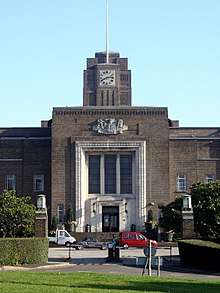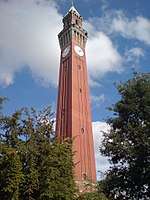University of Birmingham Medical School
The University of Birmingham Medical School is one of Britain's largest and oldest medical schools with over 400 medical, 70 pharmacy, 140 biomedical science and 130 nursing students graduating each year.[2] It is based at the University of Birmingham in Edgbaston, Birmingham, England. Since 2008, and following a departmental restructure, the school became an entity within The College of Medical and Dental Sciences.
 | |
| Type | Medical school Prof David Adams (Head of College) and (Dean of Medicine), Dr Emma Robinson (Director of Operations) |
|---|---|
| Established | 1825 - Teaching by Sands Cox begins in Birmingham 1767 - Medical teaching began at the Birmingham Workhouse Infirmary[1] |
| Location | Birmingham , United Kingdom |
| Affiliations | University of Birmingham |
| Website | www |
History
The roots of the Birmingham Medical School were in the medical education seminars of Mr. John Tomlinson, first surgeon to the Birmingham Workhouse Infirmary and later to the General Hospital. These classes were the first held in the winter of 1767–68. The first clinical teaching was undertaken by medical and surgical apprentices at the General Hospital, opened in 1779.[1] Birmingham Medical School was founded in 1825 by William Sands Cox, who began by teaching medical students in his father's house in Birmingham.[3] A new building was used from 1829 (on the site of what is now Snow Hill station). Students at this time took the licentiate/membership examinations of the Royal College of Surgeons of England, Royal College of Surgeons of Edinburgh and the Worshipful Society of Apothecaries.
In 1836, Earl Howe and a number of prominent local men submitted a memorandum to King William IV, and on 22 June a reply communicated His Majesty’s acquiescence to become a Patron of the School to be styled the Royal School of Medicine and Surgery in Birmingham. There was serious need for a new teaching hospital and in 1839 Sands Cox launched an appeal. Sufficient money was raised within a year and the hospital built in 1840–41 was opened in 1841 by Sands Cox.
Queen Victoria who had granted her patronage to the Clinical Hospital in Birmingham also allowed the new teaching hospital to be styled "The Queen’s Hospital." In 1843, the medical school became Queen's College, and students became eligible to be considered for medical degrees awarded by the University of London.[4]
A rival medical school, Syndenham College opened in Birmingham in 1851. This merged with Queen's College in 1868 to form a new combined institution, and later merged with another institution, Mason Science College. In 1897, the Mason University College Act was passed which made Mason Science College (incorporating Queen's College) into a university college, and this, in turn, became Birmingham University in 1900, and MB ChB degrees were able to be awarded by the new university.
In 1966, an outbreak of smallpox originated at University of Birmingham Medical School.[5] In 1978, Janet Parker contracted the disease while working as medical photographer in the anatomy department. She was the last person to die of smallpox in the world.
Facilities
The Medical School is now housed within a building on the University of Birmingham campus in a building constructed in 1938. The Medical School was extended to a design by Scott Wilson and constructed by Architects Design Partnership. The scheme cost £8 million and consisted of a 450-seat lecture theatre and student catering facilities.[6]
In 2013 the university invested in the creation of a new School of Pharmacy. The school is currently located in the Robert Aitken Institute of Clinical Research to the side of the main medical school building. The Pharmacy building contains: a state of the art pharmaceutics lab, separate tablet making lab, a level 3 microbiology lab and clean room, aseptics lab, e-Lab / electronic prescribing lab, clinical examination rooms and an advanced library. The pharmacy school is linked to Birmingham Old Hospital.
In October 2008, the medical school opened a new prosectorium to its students which cost in the region of £500,000 to build.
In April 2016, The Birmingham Dental Hospital and School of Dentistry opened its doors after a £50 million investment. It houses 600 undergraduate and postgraduate students and trainees and is equipped to treat over 120,000 patients a year in areas including unscheduled emergency dental care, restorative dentistry, oral surgery, oral medicine, orthodontics and paediatric dentistry.
University of Birmingham students of medicine, pharmacy, dentistry, nursing and physiotherapy have access to special clinical works within the Barnes Library and computer cluster within the medical school building. With the restructure of the university all these schools now come under the umbrella of the College of Medical and Dental Sciences.
Courses and admission
The medical school remains extremely competitive with entry requirements set very high. For the 5 year medicine course potential students are expected to have a minimum of 7 A* grades at GCSE as well as straight A predictions for A level examinations. Although these are minimum requirements, the medical school often increases its GCSE expectations. The typical offer was also increased to AAA for 2010 entry. Requirements for 2013 entry then became A*AA at A Level and A*s in English, Maths and Science GCSEs instead. Candidates are also expected to perform well at interview.
Dentistry at Birmingham often receives many applications for each place available. With few spaces on the course, it is extremely competitive and candidates are expected to perform excellently at interview.
Pharmacy admissions accepted the first intake of students in August 2013, in the first year alone 1007 applicants applied for 70 available places. Requirements for current entry remain at AAB at A Level and A's in Maths and Science GCSEs. This course was accredited by the General Pharmaceutical Council (GPhC) in June 2017.
The BNurs Nursing degree allows students to specialise in Adult, Mental Health and Child and Public Health clinical settings. A new four-year undergraduate Masters in Nursing (MNurs)starts in September 2018 which prepares students for management roles and clinical academic careers.
The Medical School runs a variety of undergraduate medical degree (MBChB) courses. There is both the five-year programme along with a four-year graduate entry course (GEC). In addition there are a small number of places on a 3-year programme allocated to dental graduates aiming for careers in Oral Medicine or Oral and Maxillofacial Surgery.
The School also offers a bachelor's degree in Biomedical Science (BSc) leading to further study at postgraduate level. Medical and Pharmacy students may also intercalate to the final year of the Biomedical Science course to attain an additional degree within their 3rd year.
For September 2018, the School is introducing a BSc Public Health programme. Requirements for entry are ABB at A Level.
The College of Medical and Dental Sciences also offers Dental Surgery (BDS), Dental Hygiene and Therapy (BSc) and Biomedical Materials Science (BMedSc). These courses are based at the Birmingham Dental Hospital and School of Dentistry.
The College of Health Sciences at the University of Zimbabwe was modelled after the Birmingham Medical School. The two hence share and enjoy a special relationship.
Medical Society (Birmingham MedSoc)
Students of Birmingham Medical School, are entitled to be part of Birmingham Medical Society, the largest society at the University of Birmingham. Birmingham MedSoc contains various subsidiary sports teams, societies and charities, which are relatively independent in their running.[7]
UBMS RFC
The oldest sports club in MedSoc, and indeed the whole university, is the Medical School Rugby Club (UBMS RFC). UBMS RFC was founded in 1958. The club won the inaugural NAMS (National Association of Medical Schools) competition in 1994 and has appeared in many finals over the years. The club has also previously beaten the University of Birmingham Rugby Team (UBRFC) in the annual varsity match.[8]
Other Clubs
Hockey Club (UBMSHC) won the National Medical Schools Cup in 2019.
References
- "History of the University of Birmingham Medical School". University of Birmingham: Medical and Dental Sciences. University of Birmingham. Retrieved 26 September 2019.
- "Programmes and Courses". University of Birmingham:College of Medical and Dental Sciences. Retrieved 2009-07-23.
- "History of the University of Birmingham Medical School, 1825 - 2001". University of Birmingham. Retrieved 27 July 2019.
- "Student lists". Archived from the original on September 14, 2010. Retrieved 7 October 2010.
- Hugh Pennington (5 September 2002). "Smallpox Scares". London Review of Books. Retrieved 2 September 2015.
- Martin Baugh. "University of Birmingham Medical School Wolfson Centre for Medical Education". Scott Wilson. Retrieved 2008-04-26.
- "Birmingham MedSoc Website". Retrieved 27 July 2019.
- "University of Birmingham Medical School RFC". National Association of Medical Schools Rugby Union. Retrieved 7 October 2019.
Bibliography
- J. T. J. Morrison (1926). William Sands Cox and the Birmingham Medical School. Birmingham: Cornish Brothers.
- A. P. Thomson (1957). A Short History of the Medical School, Birmingham, The Faculty of Medicine. A. P. Thomson (n.d.). History of the Medical School (as appeared annually in the Faculty Handbook)
Further reading
- K. D. Wilkinson (ed.) (1925). The History of the Birmingham Medical School, 1825-1925. Birmingham: Cornish Brothers.CS1 maint: extra text: authors list (link) (Special Number of the Birmingham Medical Review, December 1925)
- R. A. Cohen, "The Birmingham Dental Hospital", Birmingham Medical Review, 1957–58, 20: 331-337; and the lecture notes of the late Dr. B. T. Davis, sometime Assistant Dean, Senior Tutor and Historian of the Medical School
- Weiss MM, et al. (2004). Rethinking smallpox. Clinical Infectious Disease, 39(11): 1673–1688.
External links
- University of Birmingham Medical School website
- University of Birmingham Medical School Medical Society
